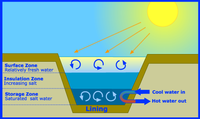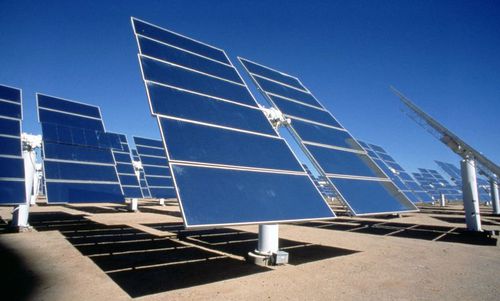Alternative energy resources
| Philosophy of Science |
While creating a resource page, please click here for a resource creation checklist
Concept Map
Error: Mind Map file alernative energy resource.mm not found
Textbook
DSERT text book class 10th scinece
Additional information
A solar thermal collector collects heat by absorbing sunlight. A collector is a device for capturing solar radiation. Solar radiation is energy in the form of electromagnetic radiation from the infrared (long) to the ultraviolet (short) wavelengths. The quantity of solar energy striking the Earth's surface averages about 1,000 watts per square meter under clear skies, depending upon weather conditions, location and orientation.
The term solar collector commonly refers to solar hot water panels, but may refer to installations such as solar parabolic troughs and solar towers; or basic installations such as solar air heaters. Solar power plants usually use the more complex collectors to generate electricity by heating a fluid to drive a turbine connected to an electrical generator.[1] Simple collectors are typically used in residential and commercial buildings for space heating.
A solar pond is simply a pool of saltwater which collects and stores solar thermal energy.
The saltwater naturally forms a vertical salinity gradient also known as a halocline, in which low-salinity water floats on top of high-salinity water. The layers of salt solutions increase in concentration with depth. Below a certain depth, the solution has a uniformly high salt concentration.
There are 3 distinct layers of water in the pond:
- The top layer, which has a low salt content.
- An intermediate insulating layer with a salt gradient, which establishes a density gradient that prevents heat exchange by natural convection.
- The bottom layer, which has a high salt content.
If the water is relatively translucent, and the pond's bottom has high optical absorption, then nearly all of the incident solar radiation (sunlight) will go into heating the bottom layer.
When solar energy is absorbed in the water, its temperature increases, causing thermal expansion and reduced density. If the water were fresh, the low-density warm water would float to the surface, causing a convection current. The temperature gradient alone causes a density gradient that decreases with depth. However the salinity gradient forms a density gradient that increases with depth, and this counteracts the temperature gradient, thus preventing heat in the lower layers from moving upwards by convection and leaving the pond. This means that the temperature at the bottom of the pond will rise to over 90 °C while the temperature at the top of the pond is usually around 30 °C. You can see solar lake in buch in gujarath.
The heat trapped in the salty bottom layer can be used for many different purposes, such as the heating of buildings or industrial hot water or to drive an organic Rankine cycle turbine or Stirling engine for generating electricity.

Biodiesel refers to a vegetable oil- or animal fat-based diesel fuel consisting of long-chain alkyl (methyl, ethyl, or propyl) esters. Biodiesel is typically made by chemically reacting lipids (e.g., vegetable oil, animal fat with an alcohol producing fatty acid esters.
Biodiesel is meant to be used in standard diesel engines and is thus distinct from the vegetable and waste oils used to fuel converted diesel engines.
Bioenergy is renewable energy made available from materials derived from biological sources. Biomass is any organic material which has stored sunlight in the form of chemical energy. As a fuel it may include wood, wood waste, straw, manure, sugarcane, and many other byproducts from a variety of agricultural processes In its most narrow sense it is a synonym to biofuel, which is fuel derived from biological sources. In its broader sense it includes biomass, the biological material used as a biofuel, as well as the social, economic, scientific and technical fields associated with using biological sources for energy. This is a common misconception, as bioenergy is the energy extracted from the biomass, as the biomass is the fuel and the bioenergy is the energy contained in the fuel
wind energy A windmill is a machine that converts the energy of wind into rotational energy by means of vanes called sails or blades. The reason for the name "windmill" is that the devices originally were developed for milling grain for food production; the name stuck when in the course of history, windmill machinery was adapted to supply power for many industrial and agricultural needs other than milling. The majority of modern windmills take the form of wind turbines used to generate electricity, or windpumps used to pump water, either for land drainage or to extract groundwater.
tidal energy Tidal power, also called tidal energy, is a form of hydropower that converts the energy of tides into useful forms of power, mainly electricity.
Although not yet widely used, tidal power has potential for future electricity generation. Tides are more predictable than wind energy and solar power. Among sources of renewable energy, tidal power has traditionally suffered from relatively high cost and limited availability of sites with sufficiently high tidal ranges or flow velocities, thus constricting its total availability. However, many recent technological developments and improvements, both in design (e.g. dynamic tidal power, tidal lagoons) and turbine technology (e.g. new axial turbines, cross flow turbines), indicate that the total availability of tidal power may be much higher than previously assumed, and that economic and environmental costs may be brought down to competitive
energy from waste
Waste-to-energy or energy-from-waste is the process of generating energy in the form of electricity and/or heat from the combustion of organic substances. Most waste processes produce electricity and/or heat directly through combustion, or produce a combustible fuel for daily usage, such as methane, methanol, ethanol or synthetic fuels.
geo thermal energy
Geothermal energy is thermal energy generated and stored in the Earth. Thermal energy is the energy that determines the temperature of matter. The geothermal energy of the Earth's crust originates from the original formation of the planet (20%) and from radioactive decay of minerals (80%). The geothermal gradient, which is the difference in temperature between the core of the planet and its surface, drives a continuous conduction of thermal energy in the form of heat from the core to the surface.
Useful websites
Reference Books
- ncert text book[[4]]
Teaching Outlines
Concept #1 solar energy
Learning objectives
- To know about the need for solar energy as alternative source of energy
- To learn the solar energy as sources of non conventional energy
- To understand need of solar energy in a decentralised system
Notes for teachers
Introduction
Alternative resources of enrgy are solar energy, bio energy, bio diesel wind energy wave energy geo termal energy.the main purpose for the studing alternative energy is day by day sources of energy are depliting rapidly due to the increased population.So we are looking towards the alternative energy resources . In this regard the alternative energy are the important issue now
We get enery from the sun in the form of solar radiation.It reaches the earth in the form of small wave packets called photons[5].The source of solar energy is continuous thermo nuclear fussion[6] taking place in the sun.
Activities
=Activity No # 1 - Name of Activity=The Shoebox Cooker in Project
Estimated Time
45 min
Materials/ Resources needed
- Shoebox
- Oven Thermometer
- Soda Cans
- Black Paint (or wide tipped felt marker)
Multimedia resources
Website interactives/ links/ simulations
Process (How to do the activity)
1. Paint a soda can black paint . If you don’t have paint you can use a felt marker , or even wrap the can with black paper. Secure the paper with tape or rubber bands. This helps the can absorb heat. 2. Use kabob stick to punch a hole through one of the long sides of the shoebox. The hole should be about 2” from the back of the box. This is for the thermometer. 3. You may have to add several layers of cardboard inside. This lets the thermometer reach the inside of the can. It also adds insulation. Try wrapping the cardboard with aluminum foil to reflect heat onto the can. 4. Attach another reflector with tape. Puncture the reflectors with kabob sticks, and and slide them through the reflectors. use the sticks to hold the reflectors open. 6. Try using a black-painted can and a plain can to see how fast each heats up. Make a chart to record your results. 5. Lay the shoebox on its side in the sun. You can lean it against a wall to face the sun. Fill the soda can about 3/4 full with water, and place it in the box. Insert the thermometer, and record the temperature. record the temperature again at regular intervals (15 minutes or more).
Developmental Questions (What discussion questions)
- why we have to wrap shoe box with black paper?
- can we use black paint insted of balck paper?
Evaluation (Questions for assessment of the child)
- what is the role of black paper in this activity?
- which is good for the solar cookoer -black paper or white paper?
Question Corner
To link back to the topic page Give the link of the page name from where activity was given Back
- Activity No #2 page_name_concept_name_activity2
Concept #2
Learning objectives
Notes for teachers
Activities
- Activity No #1 page_name_concept_name_activity1
- Activity No #2 page_name_concept_name_activity2
Concept #3
Learning objectives
Notes for teachers
Activities
- Activity No #1 page_name_concept_name_activity1
- Activity No #2 page_name_concept_name_activity2
Concept #4
Learning objectives
Notes for teachers
Activities
- Activity No #1 page_name_concept_name_activity1
- Activity No #2 page_name_concept_name_activity2
